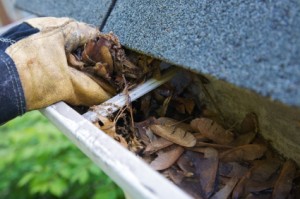How to Clean Your Eavestroughs in Ottawa

Eavestroughs, otherwise known as rain gutters, form part of the roof’s system that channels and diverts rainwater and debris from a house’s roof. The main purpose of this is to protect a property’s foundation, roof and interior by diverting water from the home. An important part of the eavestroughs is known as the down spout, which channels the collected rain water and funnels it away from the roof and house.
The following guide provides everything one needs to know in order to clean their eavestroughs. If you feel that you may not have the physical abilities to do this yourself or would rather not do it, feel free to contact a local company that specializes in this type of service.
Instructions
-
1
Prevention is Better Than Cure
When it comes to a house, water can cause an incredible amount of damage. Clogged eavestroughs can lead to foundational damage, rusting, roof damage and a plethora of other things any prideful home owner would home to avoid.
If one commits to cleaning their eavestroughs 2-3 times a year, particularly during the fall and spring season could save you from a tremendous amount of grief down the line.
Note: It is strongly suggested that everyone reading this invest in covering their eavestroughs with wire or plastic mesh. This will protect your troughs from collecting large leaves and debris that cause stagnant water and potential damage. -
2
What Will You Need?
In order to properly clean your eavestroughs, you will require the following items:
- a secure, high quality ladder
- garden gloves
- a hose with an adjustable nozzle (spray and stream options)
- a common garden trowel
- a partner to secure the ladder (optional but strongly suggested)
Note: Local hardware stores sell specialized trowels and tools that are specifically made for eavestroughs. Although such instruments are not required, some people may prefer them. We find that a regular garden trowel does the job just fine. -
3
Safety
If for any reason the ground or roof seem to be slippery or unsafe, please refrain from cleaning your eavestroughs. You can always wait for another day.
Also, when cleaning it is always better to get down from your ladder and move it over bit by bit rather than reaching and stretching at the top of the ladder. Doing so could save you from potential injury or worse. -
4
Start at the Drain Pipe (Down Spout)
The best place to begin the cleaning process is at the top of the drain pipe. This is the part of the eavestroughs that leads the water off the roof and away from the home/building.
The first thing you should do is examine the end of the down spout to make sure that there is no debris obstructing it at the base. Once you have done so, step on your ladder and use the hose to spray water down the drain pipe. This will clear any other debris that is in the pipe. You will know the pipe is clear when the water from the hose flows smoothly and clearly.
If by any chance your down spout still seems to be obstructed you may need to use a plumber's snake or a straightened wire hanger to clear debris stuck somewhere in the down spout. Be sure to not damage your down spout with these instruments.
Note: The end of the down spout should lead at least 4' from the house. It is also advisable that this spout not lead into an area where water can pool or a high traffic area. -
5
Scoop, Scrape and Spray
Once you have cleared the down spout, you will now clean the rest of your eavestroughs. Using your trowel scoop any large pieces of debris in your immediate vicinity. Once you have done so, use your hands to scrape the eavestroughs of any other dirt or debris that may have been left after you use the trowel. Last but not least, spray towards the down spout to clear everything that is left. -
6
Get Down, Move Everything Over and Keep Going
Following the same process outlined in Step 5, clean everything as well as you possibly can moving away from the down spout. Once you have reached the end of the eavestroughs furthest away from the down spout and the water that you spray runs clean and clear to the ground you have a job well done on your hands.
Once again, be sure to do this 2-3 times a year for an easier process overall and better care and maintenance for your home.







